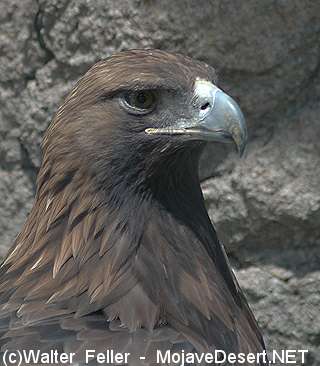Golden Eagle
The golden eagle (Aquila chrysaetos) is one of the most well-known and widespread species of eagles. Here are some key facts about golden eagles:Appearance:
Adults typically have dark brown plumage with a golden or reddish-brown nape. They have a wingspan ranging from 6 to 7 feet (1.8 to 2.1 meters). Golden eagles are powerful birds with a large, hooked beak and strong talons.Habitat:
They inhabit a wide range of environments, including mountainous regions, open grasslands, and forests. Golden eagles can be found in North America, Europe, Asia, and North Africa.Diet:
Golden eagles are carnivorous birds of prey and have a varied diet. Their primary prey includes mammals like rabbits, hares, and ground squirrels, but they are also known to hunt birds and even large prey like deer.Behavior:
They are known for their impressive soaring and gliding abilities, using thermals to stay aloft for extended periods. Golden eagles are solitary birds, and they often establish large territories for hunting and nesting.Reproduction:
Golden eagles form monogamous pairs that may last for several years. They build large nests, typically on cliffs or high rock ledges. Female eagles lay one to four eggs, and both parents participate in incubation and caring for the chicks.Conservation Status:
The conservation status of golden eagles varies across their range. In some areas, they face threats such as habitat loss, human disturbance, and persecution, while in other regions, they are more stable.Cultural Significance:
Golden eagles have been revered and featured in the folklore and mythology of various cultures throughout history. Some societies consider them symbols of strength, courage, and freedom. These majestic birds play a crucial role in maintaining ecological balance by controlling populations of prey species. They are also subjects of interest for wildlife enthusiasts and researchers studying avian behavior and ecology.
Golden Eagle
The Golden Eagle (Aquila chrysaetos) is named for the golden-colored feathers on the crown and neck. The 8-12 pound body is usually colored dark brown with a dark tipped tail and has a wing span from 6-7 feet. The Golden Eagle feeds mainly on ground squirrels, rabbits, and birds. They also feed on carrion.
The Golden Eagle is a raptor.
For more information on raptors, click here.
Also see > Birds: Carnivore: Predator: Scavenger: Diurnal
Aquila chrysaetos
Family: Accipitridae Order: Falconiformes Class: Aves
DISTRIBUTION, ABUNDANCE, AND SEASONALITY
Uncommon permanent resident and migrant throughout California, except center of
Central Valley. Perhaps more common in southern California than in north. Ranges from sea
level up to 3833 m (0-11,500 ft) (Grinnell and Miller 1944). Habitat typically rolling foothills,
mountain areas, sage-juniper flats, desert.
SPECIFIC HABITAT REQUIREMENTS
Feeding: Eats mostly lagomorphs and rodents; also takes other mammals, birds, reptiles,
and some carrion. Diet most varied in nonbreeding season. Needs open terrain for hunting;
grasslands, deserts, savannahs, and early successional stages of forest and shrub habitats.
Soars 30-90 m (98-297 ft) above ground in search of prey, or makes low, quartering flights,
often 7-8 m (23-26 ft) above ground. Occasionally searches from a perch and flies directly to
prey (Carnie 1954). Sometimes pirates food from other predators. Hunting in pairs
apparently common.
Cover: Secluded cliffs with overhanging ledges and large trees used for cover.
Reproduction: Nests on cliffs of all heights and in large trees in open areas. Alternative
nest sites are maintained, and old nests are reused. Builds large platform nest, often 3 m (10
ft) across and 1 m (3 ft) high, of sticks, twigs, and greenery. Rugged, open habitats with
canyons and escarpments used most frequently for nesting.
Water: No data found. Water needs probably met from prey.
Pattern: Uses rolling foothills and mountain terrain, wide arid plateaus deeply cut by
streams and canyons, open mountain slopes, and cliffs and rock outcrops.
SPECIES LIFE HISTORY
Activity Patterns: Yearlong, diurnal activity.
Seasonal Movements/Migration: Mostly resident, but may move downslope for winter, or
upslope after breeding season. Some migrate into California for winter.
Home Range: Home range probably same as territory. Size of home range related to
prey density and availability, and openness of terrain.
Territory: Territory estimated to average 57 km2 (22 mi2) in Idaho (Beecham and Kocher
1975), 171-192 km (66-74 mi) in Montana (McGahan 1968), 23 km (9 mi) in Utah (Smith
and Murphy 1973), 93 km (36 mi) in southern California (Dixon 1937), and 124 km (48 mi)
in northern California (Smith and Murphy 1973).
Reproduction: Breeds from late January through August; peak in March through July.
Clutch size 1-3, usually 2. Eggs laid early February to mid-May. Incubation 43-45 days
(Beebe 1974), and nestling period usuallv 65-70 days.
Niche: Occasionally preys on domestic calves and lambs. May compete with ferruginous
hawks for small mammals, and with California condors for carrion. May desert nest in early
incubation if disturbed by humans (Thelander 1974).
California Department of Fish and Game. California Interagency
Wildlife Task Group. 2005. California Wildlife Habitat Relationships version 8.1 personal computer program. Sacramento, California.